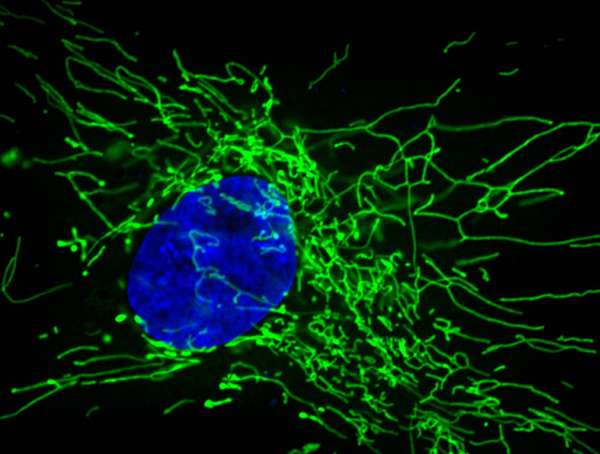Hypoxia reverses mitochondrial disease in mouse model

The next stage of a Massachusetts General Hospital (MGH) team's investigation into the therapeutic potential of the hypoxia response - the body's reaction to reduced levels of oxygen in the blood - to treat mitochondrial disease has produced findings that are promising but also reveal some limitations. The report published in the online PNAS Early Edition describes finding that, while alternatives to continuous breathing of 11 percent oxygen did not prevent symptom onset in a mouse model of Leigh syndrome - the most common pediatric mitochondrial disease - hypoxia therapy was able to reverse neurologic damage in animals close to the end stages of the disease.
"This is an extremely important next step in our exploration of the therapeutic potential of hypoxia for this neurodegenerative disease," says Vamsi Mootha, MD, of the MGH Department of Molecular Biology, co-senior author of the report. "While hypoxia regimens that might have been more practical than the one we previously described were ineffective, we were excited to find that initiating 11 percent hypoxia treatment in mice on the brink of dying produced a complete reversal of both physiologic and behavioral symptoms. These stunning results provide hope that the brain lesions of Leigh syndrome may be reversible."
Genetic defects affecting mitochondria - subcellular structures that are essential to the conversion of nutrients into cellular energy - can have devastating effects in almost any organ system. With few exceptions, there are no effective treatments for mitochondrial diseases. Leigh syndrome is characterized by the development of lesions in the brain and produces neurodegenerative symptoms including muscular weakness and movement difficulties, loss of vision or hearing, and developmental delay. Symptoms usually appear in the first year of life and lead to death within two or three years.
In their 2016 study published in Science, the MGH team first identified the potential of the hypoxia response to counteract genetic inhibition of the molecular reactions underlying mitochondrial function. They then showed that placing Ndufs4-knockout mice, an established model of Leigh syndrome, in an environment with 11 percent oxygen - about half of what is found at sea level - significantly reduced the development of typical symptoms and extended the animals' survival. A higher-than-normal oxygen environment of 55 percent accelerated death in the mouse model but had no effect on normal animals.
The current study was designed both to improve understanding of the effects of different oxygen levels on this mouse model and to see whether more practical hypoxia regimens might have results similar to those of the previous investigation. Imaging studies of Ndufs4-knockout mice raised in an 11 percent oxygen environment showed a complete lack of brain lesions at 250 days of life, while lesions appeared in less than 60 days in animals breathing 21 percent oxygen. While hypoxia-treated animals survived an average of 270 days, those raised in 21 percent oxygen only lived an average of 58 days. Breathing 55 percent oxygen led to rapid death of the Ndufs4-knockout mice from pulmonary edema, and the animals also developed lesions in the olfactory bulb of the brain.
Neither of two alternative hypoxia regimens - breathing 11 percent oxygen for only 10 hour a day or constantly breathing 17 percent oxygen - reduced or prevented the development of neurodegenerative symptoms in Ndufs4-knockout mice. Moving animals raised in an 11 percent environment into a 21 percent environment led to rapid symptom development and death, indicating the necessity of continuing treatment. However, moving 55-day-old mice raised in a 21 percent oxygen environment and already showing disease symptoms, including brain lesions, into an 11 percent oxygen environment produced rapid symptom improvement in as little as five days; and most of those animals were alive at 210 days of life.
While hypoxia treatment prevented brain disease in Ndufs4-knockout mice, it did not prevent the development of heart dysfunction, which appeared at around 150 days, well beyond the survival of untreated mice. Some Leigh syndrome patients develop a form of cardiomyopathy, and Mootha notes that other mouse models in which Ndufs4 is knocked out only in cardiac tissue develop similar heart disease, suggesting the hypoxia treatment may have no effect on that symptom.
"Mitochondrial disorders are very heterogenous," Mootha says. "Some of our ongoing work is aimed at determining whether hypoxia therapy will generalize to other models of mitochondrial disease. The results of these studies will help in our design of future translational studies. We're also working to try and identify other, more practical hypoxia regimens that may be effective. Our vision is to be able to offer patients and their families a therapy that not only halts but heals disease, but we're still only working in animal models. We're not there yet, but we've got all hands on deck to push this concept forward."
Co-senior author Warren Zapol, MD, director of the Anesthesia Center for Critical Care Research and emeritus chief of Anesthesia and Critical Care at MGH, adds some historical perspective. "We learned 60 years ago that 100 percent oxygen was toxic to the retinas of premature babies; we learned 40 years ago that breathing very high oxygen levels injured lungs. Today our team is exploring the impact of breathing 11 percent oxygen - the level found at 14,000 feet - in healthy volunteers. We are exploring hypoxic breathing carefully and slowly, and I am optimistic we will eventually find clinical applications that can help patients with these terrible diseases."
More information: Michele Ferrari el al., "Hypoxia treatment reverses neurodegenerative disease in a mouse model of Leigh syndrome," PNAS (2017). www.pnas.org/cgi/doi/10.1073/pnas.1621511114


















